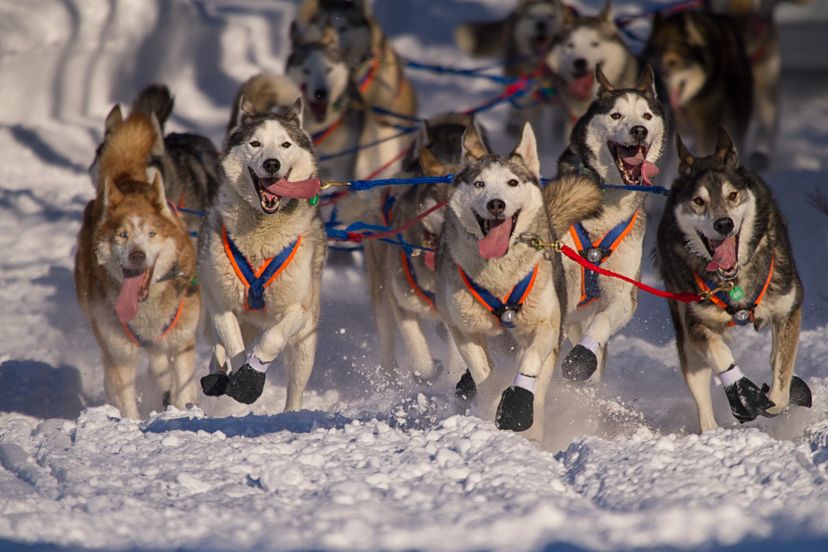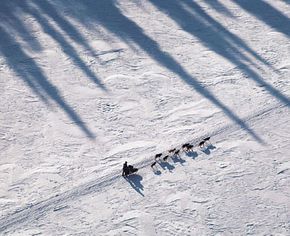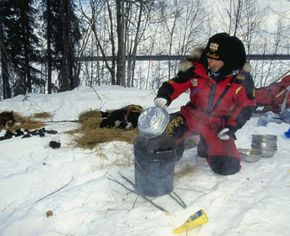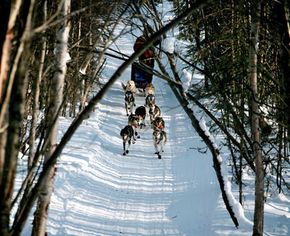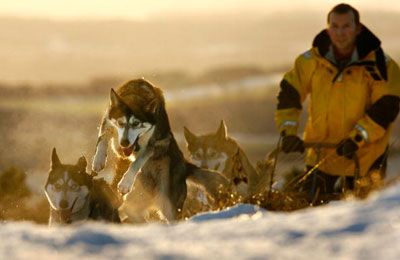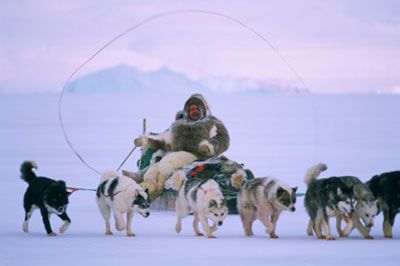Each team competing in the Iditarod Trail Sled Dog Race is made up of a dog driver, the dogs and a whole lot of gear.
The dogs that race in the Iditarod are primarily of a mixed breed, called Alaskan husky, which is not a breed recognized by the American Kennel Club. People sometimes assume the Iditarod sled dogs are Siberian husky or malamute, both official American Kennel Club breeds, but they are not the preferred dogs for most mushers. Alaskan huskies are bred for their speed and endurance. Dogs that weigh around 40 to 45 pounds are the ideal size. The most intelligent and fastest dogs are picked to be lead dogs and run in the front of the pack. Behind them run swing dogs, whose job is to direct the team around turns and curves. At the back of the dog team are the wheel dogs or wheelers, who are right in front of the sled and are usually the largest and strongest of the team. The rest of the dogs are known simply as team dogs.
The training for each team of dogs varies by musher (or whoever is preparing the dogs to race). Conditioning the dogs to run long distances is vital, and teams may cover 2,000 to 3,000 miles in the course of their training leading up to the race. Since training may take place year-round, the dogs sometimes run on dry land, and sometimes pull all-terrain vehicles.
Sled dogs need to eat around 10,000 calories per day. During the Iditarod race, that translates into about 2,000 pounds of food for one team for the entire race. Meat is the main ingredient, but other fats, oils, dry dog foods and vitamin supplements are also included. The dogs are fed at each checkpoint but they also get snacks every few hours. Before the race, mushers ship food and gear to points along the trail through the race committee so it is waiting for them at checkpoints. Gear for dogs includes fabric booties to protect their feet from the elements, and each team may go through 2,000 booties during the race.
There are a maximum of 16 dogs on a team. At the race's start there must be between 12 and 16 dogs per entrant. At the race's end, at least six dogs must be part of the team that crosses the finish line. During the race, teams typically travel 5 to12 mph.
Mushers
Though competitors may have people who assist with race preparations the rest of the year, when it comes time for the Iditarod, the musher must compete on his or her own. What makes a good musher? Strong leg muscles and good balance help, but mental stamina is clearly required.
For the race, mushers are required to pack a sleeping bag, an ax, snowshoes, and a cooker or pot and fuel for boiling water. They outfit themselves in attire that will protect them from the harsh elements, including warm boots and eye goggles. Ski poles, a gun, a headlamp and food are among the other supplies carried on the trail.
Mushers sleep very little during the race. There is a designated sleeping area for the dog drivers at each checkpoint, but other than one 24-hour and two eight-hour mandatory rests, competitors push themselves to stay awake.
Sleds
The official race rules require that "some type of sled or toboggan must be drawn" but specifications are up to each racer. Typically, the sleds used weigh around 100 pounds (easily twice that once loaded with gear) and cost around $1,500. They have a basket where gear is carried and a tired dog can rest, and are outfitted with a braking device. Mushers stand on the sled's runners, which are usually made of wood and covered in plastic or Teflon, and extend out from the sled's basket.
The dogs are attached to the sled with a series of lines called rigging. This includes the tow line (or gang line), tug lines and neck lines. The dogs each wear a collar and a harness. The tow line connects the dogs to the sled. The tug line connects the dogs' harnesses to the tow line. The neck line connects the dogs' collars to the tow line. There are no reins, and dogs respond to the musher's vocal commands.
Tether lines and stakes are used to secure dogs during breaks. A snow hook or ice hook, a heavy piece of metal that can be set into the snow, is also used to restrain the team as needed. A snub line is a piece of rope that connects the sled to a tree or other object when not in use.
